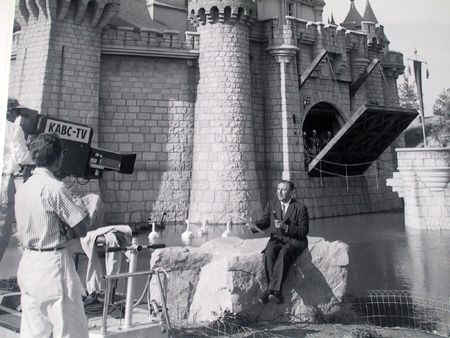“All major theme parks have delays. When they opened Disneyland in 1956, nothing worked!”
“Yeah, but John, if The Pirates of the Caribbean breaks down, the pirates don’t eat the tourists.”
Though of course Disneyland opened in 1955 and Pirates opened in 1967. Still, it’s fascinating to me exactly how things worked when Disneyland did open. The technical details are well established. The pavement melted and trapped women’s heels. The plumbing was so far behind that they had the choice of hooking up the water fountains or the bathrooms. (Wisely, they chose the latter.) People assumed this was a ploy to sell Pepsi, as Pepsi was one of the park’s sponsors, but it was in fact the result of a plumbing strike. Things in general were so unprepared that Walt gave return tickets to attendees—many of whom had entered the park illegally in the first place.
Amidst all of this, and in many ways as disorganized, was a broadcast for ABC. It was hosted by Art Linkletter. There were cameras all over the park; guests, of course, tripped on the cables. Linkletter’s cohosts were Robert Cummings and Ronald Reagan. There were multiple dedications by Walt himself, a song by Fess Parker and Buddy Ebsen, and a dedication of the Mark Twain by Irene Dunne, who turns out to have steamships in two generations of her family history. There was Frank Sinatra and Sammy Davis, Jr., on the Autopia. Bobby Driscoll on the pirate ship. And a weird stalking of Danny Thomas and his family.
It’s not something I think we’d get today, even if almost every TV in the country was turned to it. California governor Goodwin Knight was one of the guests. A priest, a minister, and a rabbi were prominent guests, and somehow, it wasn’t a set-up to a joke. The minister even delivered a prayer. It’s as though no one notices that the whole thing is a giant ad all by itself; we keep cutting away for ads for other things. Though I suspect that’s at least in part in order to give the technical folks a break for a minute.
They apologized in advance for technical difficulties. This was incredibly complicated for a live broadcast of the time. I think in many ways it was one of the most complicated broadcasts in the history of television. The technology wasn’t there. Broadcast and park alike were stretching the state of the art. I grant you the park wasn’t much, just in the first days, but I’m not sure there had ever been a park quite like Disneyland—and it seemed for quite some time that each ride would just get more complicated than the last; while many of the original rides were mule trains and horse-drawn trolleys and so forth, there were already four dark rides in Fantasyland. It would be less than ten years until Audio-Animatronics started to be a dominant feature in the park.
For now, there was much bragging about the gas engines on the Autopia and the Phantom Boats. (I always liked the latter better than the former, and I’m disappointed that Autopia is now huge and Cars-themed and the boats are gone.) A lot of talking about the authenticity, albeit at reduced scale, of the Mark Twain. They, um, don’t mention The Wizard of Bras, but we do see pretty much the entire Rocket to the Moon.
Actually, the thing that amused me most was the continual talk about how Tomorrowland was set in the far-off futuristic year of 1986. Which, um, yes. I don’t think anyone there would have believed you if you’d predicted that, in 1986, Walt would be dead, the animation unit would be essentially moribund, and people would pronounce “Reagan” right because Ronald would be President. Certainly they can be forgive for not predicting the Challenger disaster, of course.
I’m not sure most people realize how much work was involved in this. Cameras in the old days were bulky, fiddly things. I’ve operated a ’60s-era TV camera, and even that was relatively easy to use compared to what would have been in operation here. The cable covers we used to keep people from tripping and disconnecting things didn’t exist yet. There was no control room handy, either, no easy hook-up to a studio with all the benefits of television infrastructure. This had to be done just right. And it wasn’t. There’s a bit where they transfer to Bob Cummings at the wrong time, but Ark Linkletter no longer has a microphone. Walt starts reading a dedication twice because he didn’t think he was on the air the first time. In some ways, the broadcast went worse than the park itself.
It is not, in short, the most glowing advertisement of the park ever. The publicity in the first weeks, even months, of Disneyland was one string of terrible reports. You can even see a few of the issues in this show, no matter how much they doubtless wished to avoid that. Putting it on life TV is one of the boldest strokes Disney ever did, and that’s in a history of bold efforts. And at the time, Walt didn’t even really trust television.
Help my family save for a Disney experience of our own; consider supporting my Patreon!

